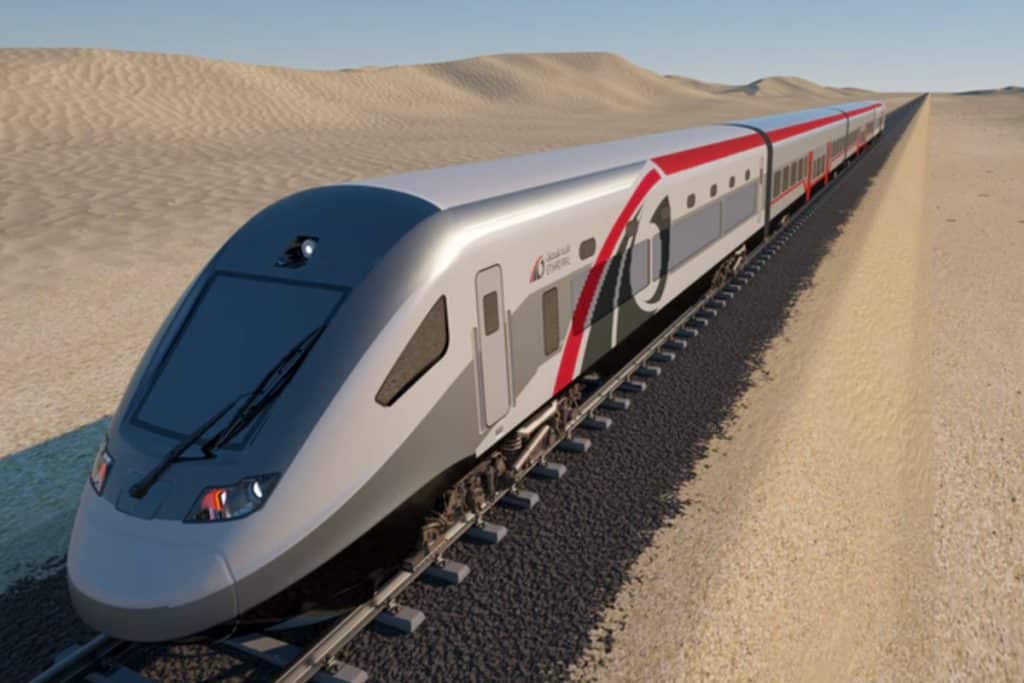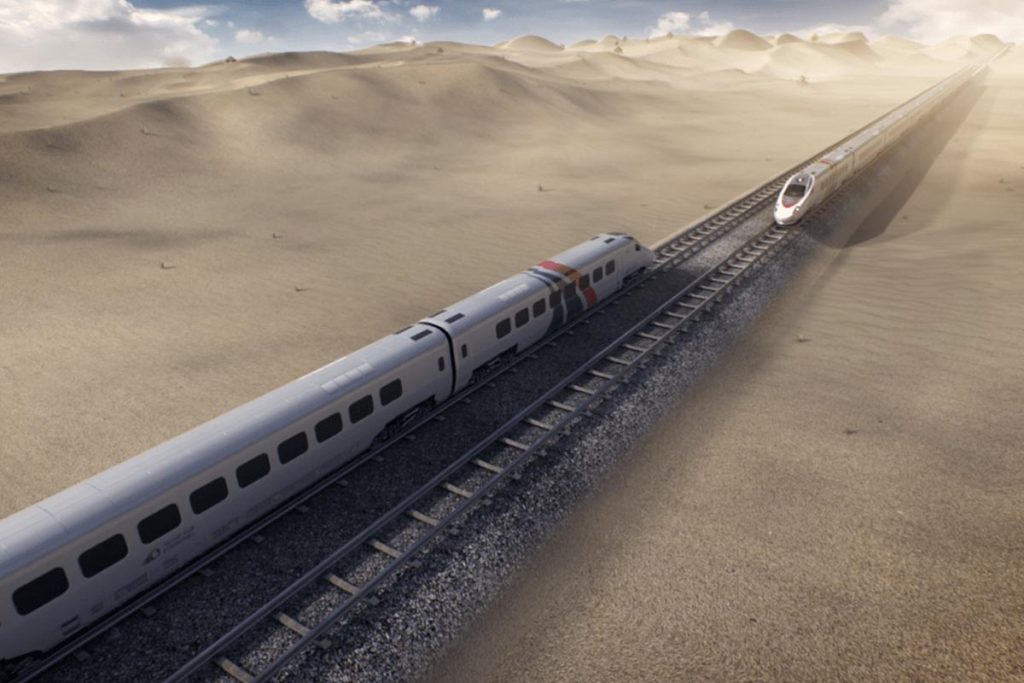Etihad Rail‘s UAE-Oman link will lower trading costs, the project’s deputy project manager Khuloud Al Mazrouei told Arabian Business in an exclusive interview.
“Each one of our facilities is state-of-the-art, using cutting edge technology to ensure that goods can be smoothly and seamlessly transferred across different forms of transport,” Al Mazrouei explained, adding that by doing so, the railway project “will help companies reduce storage times, improve logistics efficiency, and divest capital into business growth.”
Al Mazroeui explained that by lowering the cost of trade and improving the market position of existing industries, Etihad Rail will also contribute to the UAE’s economic diversification.

“Another state-of-the-art technology which we have integrated into our operations has been our surveillance systems, providing constant inspection of the rail network. Through such vigilance, Etihad Rail engineers can be alerted and monitored to potential issues, even before they have taken place, and ensure that our track remains safe for all around it,” she said.
In a very recent update, the Etihad Rail tracks were revealed to pass through the Al Maha Forest in Abu Dhabi.
“Take a look at our tracks in Al Maha Forest in Abu Dhabi, a beautiful destination to observe the rare desert dwellers. Etihad Rail took careful measures to protect the natural habitats and wildlife through the construction of bridges, canals and animal crossings, which strengthen the UAE’s integrated and sustainable transport ecosystem,” Etihad Rail said in a post via Twitter.
While works on the Etihad Rail passenger train is still underway, commuters will be met scenic view of forest and its natural habitat.
“As the developer and operator of the UAE’s national railway network, we consciously support heritage conservation and eco-tourism projects, and act as a steward for nature and the environment, ultimately boosting quality of life. We take active steps towards supporting local communities by driving employment in the vital rail and tourism sectors, preserving local culture and boosting tourism,” Al Mazrouei said.
Etihad Rail has partnered with Emirates Nature-WWF to ensure mitigation of effects of the railway development on the natural environment and local communities.
“We are also working with The Environment Agency – Abu Dhabi (EAD) to ensure the highest sustainability standards across construction of rail network,” Al Mazrouei added.
As of now, Sidr and Date Palms have been relocated, whereas over 550 Ghaf trees being successfully translocated and a further 590 trees planted.
Al Mazrouei also said that “wildlife corridors along the length of the approximately 1,200 km long project,” are being constructed, and will include 95 animal crossings and culverts.
Aside from the current developments, here is all you need to know about the UAE’s upcoming railway project:
What is Etihad Rail?
The entity was first established in June 2009, under Federal Law No. 2, with the mandate to manage the development, construction and operation of the UAE’s national freight and passenger railway network.
Stage One of the project became operational in 2016, and has been transporting up to “22,000 tonnes of granulated sulphur each day from Habshan and Shah to an export point in Ruwais on behalf of ADNOC,” according to the company website.
Stage One of the national railway network consists of two tracks, which extends up to 264 kilometres, with each train pulling up to 110 wagons.

Once completed, Etihad Rail will connect all the seven emirates of UAE, to the five neighbouring countries.
Stage Two, included the linking of UAE and Saudi Arabia from the Fujairah Port to Ghuwaifat, through Mussafah, Khalifa and Jebel Ali ports, with over 600 kilometres of additional track.
On October 12, Etihad Rail, completed the tracklaying works of the main line in Sharjah, which extends over 45 kilometres and Ras Al Khaimah, as part of the last package of Stage Two of the project.
“Connecting the Emirate to the main line recorded more than 11.7 million work hours in 25 months,” Etihad Rail said in a statement.
The line in Ras Al Khaimah, which extends over 5.7 km and connects the Emirate to the main line, recorded more than 1.3 million hours in 25 months, by around 350 workers and engineers.
Together, the two phases will support over 9,000 jobs, especially for UAE nationals.
In November 2021, Etihad Rail also completed excavation work on nine tunnels over 7 kilometres, some of which involved excavating through the Hajar mountain range on the East Coast.
The Etihad Rail will be extended into Oman, after both countries signed a deal to build a new $3 billion railway for both freight and passengers.
Reducing carbon emissions, lorry trips
In addition, the rail is also expected to replace 5,600 trips made by lorries each day.
The national railway network will also reduce greenhouse gases by over 2.2 million tonnes annually, equivalent to taking at least 375,000 vehicles off the road.
“In fact, the rail network can contribute to an overall reduction in CO2 by 21% per year in 2050, while reducing pollution, lowering fuel and maintenance costs, and increasing road safety and security,” Al Mazrouei said.
Additionally, Etihad Rail’s tracks – which is made with no road intersections – will use modern technology that will “not have joints,” thus reducing the noise intrusion when trains pass.

“The ballast used beneath the tracks is formulated specially to absorb energy and noise,” Etihad Rail said on their website adding, “sound levels generated by Etihad Rail trains are therefore minor; for example, the decibel (dB) range for freight trains travelling at 100 kilometres per hour, with three locomotives and 110 wagons in normal circumstances should not exceed 88 dB at a distance of 25 meters.”
Transportation and locomotives
As of now, there are seven locomotives in operation along the Etihad Rail’s tracks, to deliver sulphur.
The trains, which were supplied by US-based Electro-Motive Diesel, are also equipped with European signalling systems, “in order to ensure safety, security, and reliability, in addition to efficiency and sustainability.”
Each locomotive can pull 100 wagons, which is equivalent to the capacity of 300 trucks. The wagons are also equipped with extended safety features, those of which include pneumatic brakes that are electronically controlled and derailment protection.
When can I take a ride on the Etihad Rail?
The Etihad Rail is set to extend its operations to commuters by 2030. While authorities have yet to reveal an official date, Etihad Rail said “by 2030, the number of passengers is expected to reach more than 36.5 million annually” in a statement made in December 2021.
The new passenger service will run as fast as 200 kilometres per hour, with stations stretching from Sila near the Saudi border to Fujairah on the East Coast.
Passengers, will be able “to travel from Abu Dhabi to Dubai in 50 minutes, and from Abu Dhabi to Fujairah in 100 minutes,” the statement said.
The national railway network is currently working closely with the Federal Transport Authority and various transport authorities across UAE to continue its development of existing networks to improve passenger connections.
“The railway also offers a value to the time saved due to reduced road delays by car, bus, taxi and freight users who shift to the rail network, as it accounts for station-to-station road and rail time and distance travelled. In addition, there will be a large reduction in rates of accidents as rail use will lead to a lower number of kilometres travelled on the roads and hence fewer road accidents per year,” Al Mazrouei said.
The UAE-Oman link in particular will provide a “rapid, safe, and efficient passenger services,” she added.
“Running up to 200 kilometre per hour on a 303km track, the passenger train will enable travelling between Abu Dhabi and Sohar in 1 hour 40 minutes, and between Sohar and Al Ain in 47 minutes only. Upon its completion, the network will be linked to the UAE National Rail Network, facilitating the movement of the residents of the two countries, an enhancing tourism,” she concluded.








